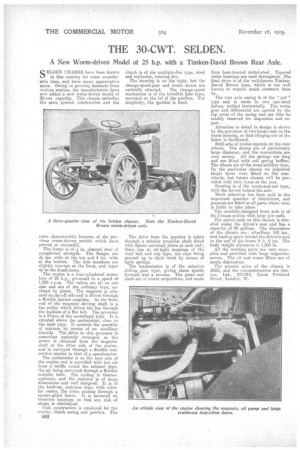THE 30-CWT. SELDEN.
Page 26

If you've noticed an error in this article please click here to report it so we can fix it.
A New Worm-driven Model of 25 h.p. with a Timken-David Brown Rear Axle.
SELDEN CHASSIS have been known in this country for some consider' able time, and have many appreciative users. Owing to growing demands from various sources, the manufacturers have now added a new worm-driven model of 30-cwt, capacity. This chassis embodies the same general construction and the
came characteristic features of the previous worm-driven. . models which have proved so successful.
The frame is of in. channel steel of exceptional strength. The flanges are 4 ins. -wide at the top and 4 ins, wide at the bottom. The side members are slightly inswept at the front, and taper up to the dumb-irons.
The engine is a four-cylindered monobloc of 25 h.p., governed to a speed of 1,200 r.p.m. The valves are all on one side and are of the ordinary type, enclosed by plates. The magneto is situ ated on the off side and is driven through a flexible loather coupling. At the front, end of the -magneto driving shaft is a fan pulley which drives the fan through the medium of a flat belt. The governor is a Pierce of the centrifugal type. It is situated above the carburetter, close to the inlet pipe. It controls the quantity of mixture by means of an auxiliary ' throttle The drive to this governor is somewhat curiously arranged, as the power is obtained from the magneto shaft at the other side of the engine, and is conveyed through a flexible con nection similar to that of a speedometer. The carburetter is on the near side of the engine and is provided with hot air from a muffle round the exhaust pipe, the air being conveyed through a flexible metallic tube. The "cooling is flume syphonic, and the radiator is of large dimensions and well designed. It is of the built-up, east-iron type, with tubu lar centre, the tubes passing through a square-gilled frame. It is mounted on trunnion bearings, so that any risk of strain is eliminated.
Unit construction is employed for the engine, clutch easing and gearbox. The B52 clutch is of the multiple-disc type, steel and raybestos, running dry. The steering is on the right, but the change-speed-gear and brake levers are
centrally situated. The change-speed mechanism is of the invisible Rate type, mounted on the lid of the gearbox. For simplicity, the ignition is fixed.
The drive from the gearbox is taken through a tubular propeller shaft fitted with Spicer universal joints at each end; these run in oil-tight housings of the steel ball awl cup type, the cups being pressed up to their work -by means of light springs. The transmission is of the selective sliding gear type, giving three speeds forward and a reverse. The gears and shaft are of ample proportions, and made from heat-treated nickel-steel. Tapered roller bearings are used throughout. The final drive is of the well-known TimkenDavid Brown type, which is too well known to require much comment front us.
The rear axle casing is Of the "pot" type and is made in two cast-steel halves, welded horizontally. The worra gear and differential are carried by the top cover of the casing and can thus be readily removed for inspection and repair.
Attention to detail in design is shown by the provision of two hooks cast On the worm housing, so that slinging out of the latter is facilitated.
Both sets of brakes operate on the rear wheels. The drums are of partioularly large diameter, and the connections are very strong. All the springs are long' and are fitted with coil spring buffers.
The wheels are of the wood artillery type. On the particular chassis we inspected tingle tyros were Wed on Die rear wheels, but future chassis will be proe vided with twin tyres at the rear.
Steering is of the worm-and-nut type, with the tie-rod behind the axle.
Much attention has been paid to the important question of lubrication, and greasers are fitted to all parts where wear is liable to take place.
The carefully-designed front axle is of the I-beam section with large law ends. The petrol tank on this chassis is situated under the driver's seat and has a capacity of 20 gallons. The dimensions of the chassis are : wheelbase 140 ins., and loading space behind the driver's seat to the end of the frame 9 ft. 6 ins. The body weight allowance is 1,000 lb. All the working parts are very accessible and provided with large inspection covers. The oil and water fillers are of ample dimensions.
The present 'price of the chassis is £625, and the concessiennaires are Gaston, Ltd., 212-214, Great Portland Street, London, W.




























